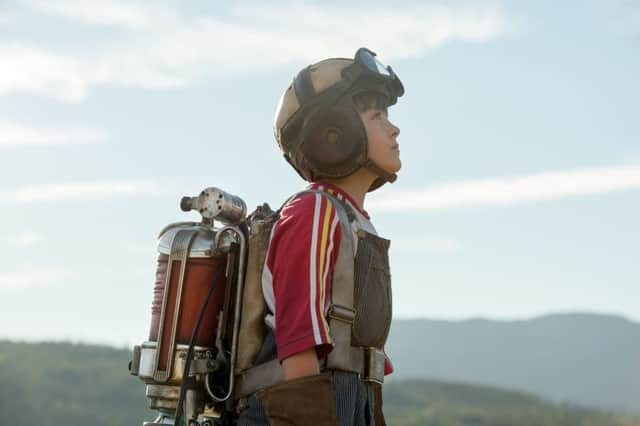Film review: Tomorrowland: A World Beyond


Tomorrowland: A World Beyond (PG)
Directed by: Brad Bird
Starring: George Clooney, Britt Robertson, Rafey Cassidy * * * *
Actually, scratch that. When a film comes along and behaves exactly like a rollercoaster only to derail expectations midway through, that’s what causes the disorientation. Disney’s big new family sci-fi blockbuster Tomorrowland: A World Beyond is a movie like that. Directed and co-written by Brad Bird, the animation whiz behind The Iron Giant, The Incredibles and Ratatouille, the film’s first hour feels like a fairly rote and somewhat groan-worthy piece of blockbuster entertainment, as overblown as Bird’s previous live-action movie, Mission: Impossible – Ghost Protocol. Yet, as the film progresses, it gradually becomes clear there’s something else at work here, that the empty spectacle it’s feeding us may actually have a larger storytelling purpose.
Advertisement
Hide AdIt’s important to bear that in mind because the film’s first half feels like a self-satisfied tribute to its own sense of wonderment, with characters reacting with awe to things most moviegoers will have witnessed countless times before. It also feels like an insidious advert for Disney’s various properties, from branded theme parks to Star Wars merchandise. The film itself was inspired by a zone within the original Disneyland designed to celebrate the endless possibilities of the future and Bird and his co-screenwriter, Lost creator Damien Lindelhof, have taken that concept and imagined it as a parallel universe in which talented thinkers, inventors and artists can gather, create and collaborate on fixing the world’s problems, unencumbered by bureaucracy or governments.
The first act of the film is also set amidst the Disney-designed exhibits of the 1964 New York World’s Fair, which offered a vision of the future that was already antiquated even then, untroubled by the imminent arrival of psychedelia and civil unrest. It’s here where we’re first introduced to a young dreamer by the name of Frank Walker (played Thomas Robinson), who arrives with an almost-working jet pack and an unshakeable belief in the inspirational power of fun. This attracts the attention and admiration of a self-possessed girl called Athena (Raffey Cassidy), who sneaks him into the aforementioned Tomorrowland, whereupon he’s confronted with robots, space shuttles and floating monorails that blow his mind, if not ours.
The film then jumps forward 45 years. Frank is no longer a giggling, awe-struck optimist, but a crabby, middle-aged man who takes the form of George Clooney. In other circumstances that might be the cue for a film to settle into star vehicle territory, but in an initially frustrating but ultimately worthwhile move, Tomorrowland abandons his story for resumption in the second half in order to introduce the film’s true protagonist, a bright, vivacious teenager by the name of Casey Newton (Britt Robertson). She’s the daughter of an about-to-be-made redundant NASA engineer and, like a perkier Murph from Interstellar, has a fascination with space travel and a mischievous determination to challenge her teachers’ innate pessimism regarding the dire state of the planet.
It’s this refusal to accept the Chicken Little version of history that leads her to Tomorrowland, courtesy of a suddenly materialising magic pin that acts like a conduit between these two dimensions. What follows, though, is a series of fairly relentless action set-pieces that dispiritingly resemble every recent Hunger Games knock-off imaginable as Casey is chased by sinister government agents, and kids engage in kick-ass fist fights with burly adults.
And then something genuinely interesting happens.
Just when the film looks as if it’s going to take a left down Divergent Alley and get lost in Maze Runner Plaza, the film rejoins Clooney’s character and Bird subtly shelves all the generic action. Instead, he allows already-seeded themes about the need to celebrate creativity to blossom and transforms the film into a critique of our cultural obsession with destruction and despair, recasting the first half of the movie in something of a new light. The film contravenes blockbuster law, too, by becoming talkier as it progresses. It becomes more interested in character and performance, with the bond between Casey and Frank deepening, and the race to save the world from imminent destruction turned into an accessibly compelling philosophical discussion about the nature of self-fulfilling prophecies. And while there continues to be spectacle, its emphasis changes: instead of raining destruction down upon global landmarks, those landmarks become alternative platforms for incredible feats of human engineering and imagination. Like a classic Pixar film, Tomorrowland starts demonstrating utter confidence in its own ideas, letting Bird (no stranger to the animation studio’s risk-taking culture) pull off a nifty bait-and-switch: promising the simple thrills and spills of a ride, but understanding the deeper satisfaction that can be had by engaging the mind.